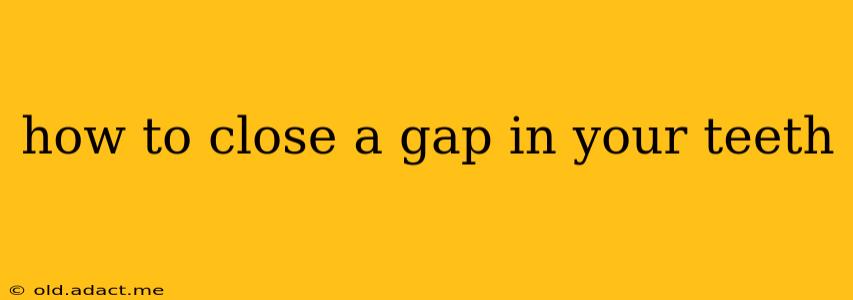A gap between your teeth, also known as a diastema, can be a source of self-consciousness for some. Fortunately, there are several ways to close this gap, ranging from simple cosmetic solutions to more involved orthodontic treatments. This comprehensive guide will explore your options, helping you make an informed decision based on your individual needs and preferences.
What Causes Gaps Between Teeth?
Understanding the underlying cause of your diastema is crucial in determining the best treatment approach. Several factors can contribute to gaps:
- Genetics: Family history of wide gaps often plays a significant role. The size and shape of your jaw and teeth are largely determined by genetics.
- Missing Teeth: The absence of teeth can cause adjacent teeth to shift and create gaps.
- Gum Disease: Gum disease (periodontal disease) can damage the supporting tissues around teeth, leading to increased spacing.
- Thumb Sucking or Tongue Thrusting: These habits, especially during childhood, can exert pressure on teeth, causing them to misalign and create gaps.
- Improper Jaw Growth: An abnormally sized jawbone can result in teeth not having enough room to fit comfortably, leading to spacing.
How Can I Close a Gap in My Teeth?
The method for closing a gap depends on the size of the gap, its cause, and your personal preferences. Here are some common options:
1. Orthodontic Treatment (Braces or Invisalign):
This is the most common and effective method for closing gaps, particularly larger ones. Braces use wires and brackets to gradually shift teeth into the desired position. Invisalign utilizes a series of clear aligners that are changed every few weeks, achieving the same result more discreetly. Orthodontic treatment addresses the underlying cause of the gap and provides a long-term solution.
2. Veneers:
Veneers are thin shells of porcelain or composite resin that are bonded to the front surface of teeth. They can effectively mask smaller gaps, improving the overall appearance of your smile. This is a less invasive option compared to orthodontics, but it doesn't address the underlying cause of the gap.
3. Bonding:
Dental bonding involves applying a tooth-colored composite resin to the teeth, shaping and polishing it to close the gap. This is a less expensive and less time-consuming option than veneers, but it may not be as durable and might require more frequent touch-ups.
4. Tooth Reshaping (Odontoplasty):
In some cases, where the gap is minor and caused by unevenly shaped teeth, a dentist can carefully reshape the teeth to close the gap. This is a simple, quick procedure, but it's only suitable for small gaps.
What are the Costs Involved in Closing a Gap?
The cost of closing a gap varies significantly depending on the chosen method, the severity of the gap, and your location. Orthodontic treatment is generally the most expensive option, while bonding is typically the least expensive. It's essential to consult with your dentist or orthodontist to get a personalized cost estimate.
How Long Does it Take to Close a Gap in My Teeth?
The treatment duration depends on the chosen method and the severity of the gap. Orthodontic treatment can take anywhere from 6 months to 2 years, while veneers and bonding are typically completed in a single appointment or a few visits.
Are There Any Risks or Complications Associated with Closing a Gap?
As with any dental procedure, there are potential risks and complications. Orthodontic treatment can cause temporary discomfort, and there's a risk of tooth sensitivity. Veneers and bonding can chip or stain over time. It's crucial to discuss these risks with your dentist or orthodontist before proceeding with treatment.
What is the Best Way to Close a Gap Between My Two Front Teeth?
The best way to close a gap between your front teeth depends on the size of the gap and its underlying cause. For smaller gaps, veneers or bonding might be sufficient. However, for larger gaps, orthodontic treatment is usually necessary to achieve the best long-term results. A consultation with a dentist or orthodontist will determine the most suitable option.
By understanding the causes and treatment options available, you can make an informed decision about the best way to close the gap in your teeth and achieve the confident smile you desire. Remember to always consult with a qualified dental professional for personalized advice and treatment planning.
